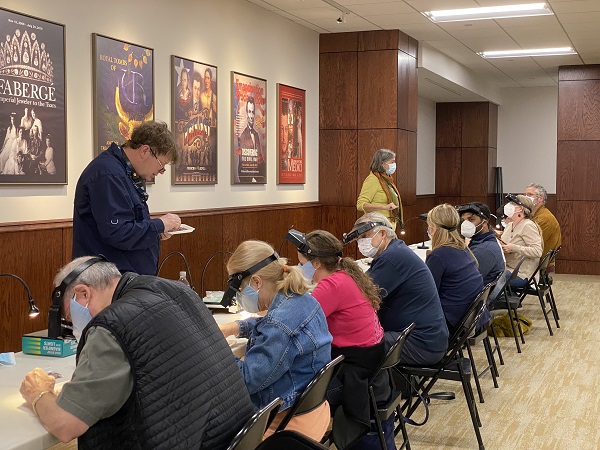Editor’s note: Today’s blog comes to us from paleontologist and field volunteer Neal Immega.
You all know by now that the museum has a dig in Seymour where we are finding fabulous Permian fossils, including the toothy Dimetrodon and the weird boomerang-headed salamander Diplocaulus. We don’t dig in just one place; lots of people go prospecting for new sites (or maybe they are just looking for a private spot to do their business).
A previous blog topic was on a weird lump that turned out to be a caliche ball. Today we have another lumpy rock to look at. This specimen was collected by geologist Gretchen Sparks, who brought it in just to plague me. Let’s see just how much information we can squeeze out of it:
At first glance, it’s just a rock showing cross-bedded sandstone with low-angled bedding, doubtless caused by water deposition in the Permian creek that crossed our digging area. This is pretty normal stuff. We see cross-bedding everywhere at the dig site, because the sandstone is durable and stands in relief.
But why is it lumpy? The bulge in this picture is not exactly standard:
It gets better. The rock is too heavy to be only quartz. A heavy, light-colored sandstone is likely to be cemented by barite (barium sulfate). Let’s cut the rock in half and polish the face.
 This is turning out better than I expected. You can see a seam of barite cutting the nodule vertically in half. The sandstone shows horizontal layers which correspond to the cross-bedding.
This is turning out better than I expected. You can see a seam of barite cutting the nodule vertically in half. The sandstone shows horizontal layers which correspond to the cross-bedding.
What about the red-colored area? The area we are working in North Texas is called the Permian Red Beds because everything got oxidized from prolonged exposure to the atmosphere. It was a really dry time, and the critters stayed close to the Permian creek which deposited these sediments. It is good for us because the fossil remains are concentrated in a small area (our dig site is just about the size of a tennis court).
Let’s consider this possible sequence of events.
1. 250 million years ago, sandstone was deposited in a creek. It is all cross-bedded.
2. The sand grains were likely coated with iron oxide and thus turned red.
3. The sandstone was buried by maybe 1000-plus feet of additional rock.
4. Shales deeper in the geological section were heated by the normal geothermal gradient to hundreds of degrees and adsorbed water was squeezed out, taking with it the barium that was also adsorbed (from the ocean) on to the clay surfaces. The water moved vertically along cracks in the rock.
5. When the barium reached the rocks we are digging in, the barium precipitated because the pore water is very “hard” with dissolved gypsum. The barium reacts with the local sulfate, producing barium sulfate which is essentially insoluble in water. It is the ultimate “hard water” scum.
6. The barite precipitated as the vertical seam and filled the pore space in the red rock.
7. A whole lot of rock was eroded in the next 250 million years to bring us to the present and the rocks back to the surface.
8. 10 to 100-thousand years ago or so, North Texas was in an Ice Age, and it was really wet with lots of vegetation. Decomposing vegetation created a reducing environment which dissolved iron right out of the rock. Barite is very chemically resistant, and this lump could have been at the surface through part of the ice age. The iron could have partially leached out of the lump at that time. You can see that the leaching went deeper into the lump where there are horizontal fractures in the rock.
All this from a lump of rock. Thanks, Gretchen!









